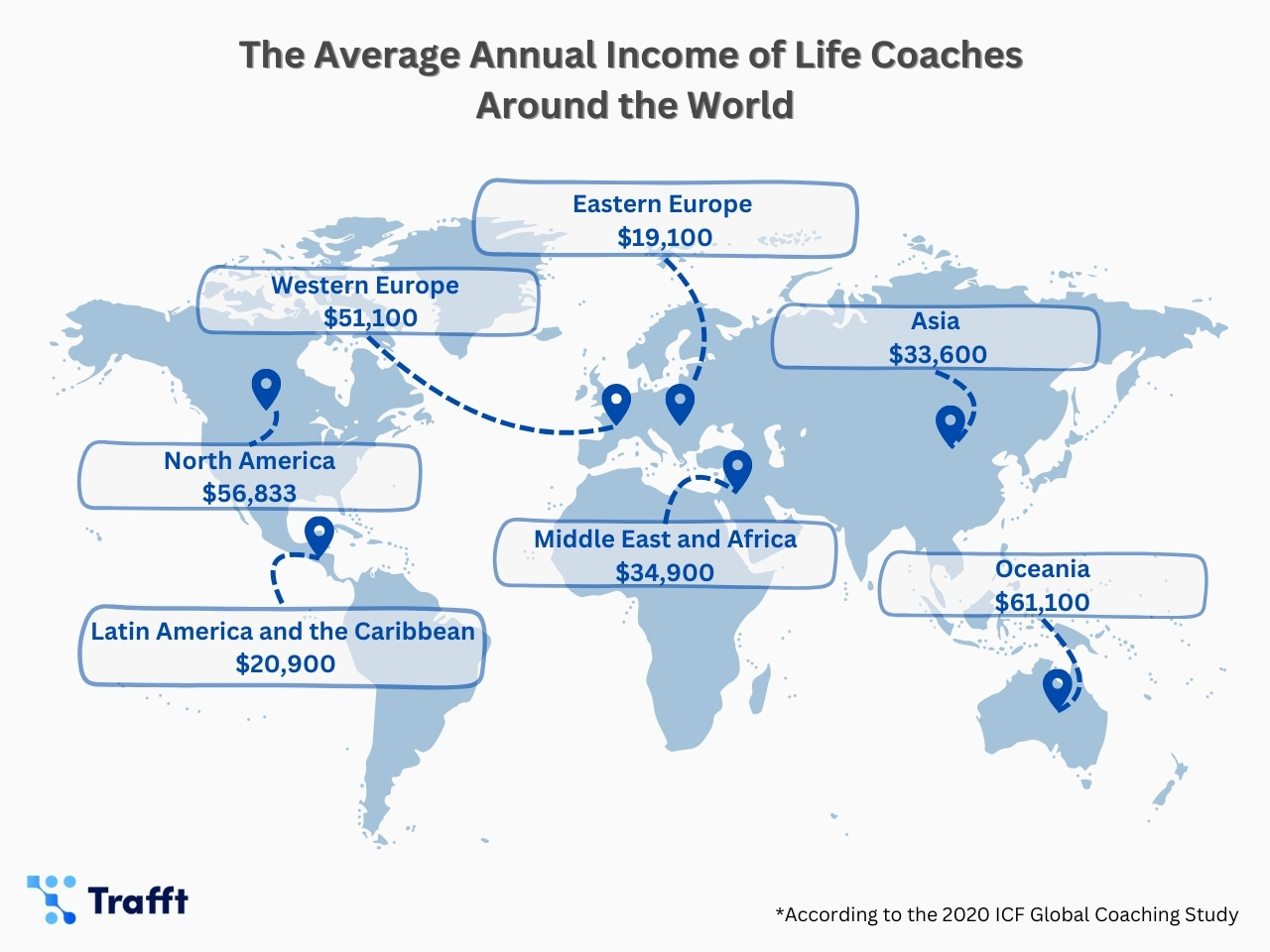More and more people are looking for guidance with switching careers, establishing their own business, better organization, and enhancing their sales or marketing know-how. There’s a boom in the life coaching industry in the U.S., turning it into a very lucrative career option.
People are looking to life coaches for support through the difficulties of daily living. The coaching industry has established itself in supporting individuals through beneficial life transformations.
There aren’t many hurdles in breaking into the life coaching market. The financial investment required to start your own venture is minimal. You wouldn’t need a degree or certificate either.
Many potential life coaches are eager to share their life and professional knowledge and profit from it. A careful examination of life coaching statistics will reveals that most coaching clients benefited from the services they paid for.
Here's a top-notch list of life coaching statistics. They form a big picture of the coaching industry's present situation and what's on the horizon for the future. Piqued your interest? Then read on.
What is a Life Coach?
Life coaches help individuals construct a life map that plots out the most effective paths throughout their journey to self-improvement. They are the impartial sidekicks their clients need while working on professional, personal and family life goals. During weekly or bi-weekly one-hour sessions, life coaches ensure clients remain dedicated and responsible toward those goals.
Life coaching is a unique service that distinguishes itself from traditional therapy, mentoring, training and consulting. Life coaching services touch on a variety of needs since people areas diverse as their goals. From personal growth and professional transformation to divorce, grief and even nutritional counseling, a life coach can guide a person through life's bigger issues.
So, what exactly does a life coach do? Much of it depends on an individual's specific objectives, but here’s a look at what's expected of an effective life coach:
- Develop better time and stress management
- Setting priorities
- Boost self-confidence, self-empathy and morale
- Enhance communication skills
- Refine work-life balance
- Establish harmony between physical and emotional health
- Improve mental clarity and well-being
- Better interpersonal skills
- Improve endurance and fortitude
- Encourage people to discover purpose and meaning in their lives
- Help client define and pursue their passion
- Handle stress better, and create stress-coping mechanisms
- Improve sleeping habits
- Establish beneficial awareness of community, engage in promoting diversity, inclusion and equality
- Work through change, indecision, and the unfamiliar
Key Advantages of Life Coaching
Life coaches have proven helpful in a variety of niches in the global life coaching industry. Likely, you have knowledge and skills that would make a difference in someone’s life.
Below are 12 reports featuring life-coaching statistics. They highlight the value coaches have brought to their clients:
- In one International Coaching Federation (ICF) study, 72% of participants noticeably improved their communication skills after working with a life coach.
- Confidence and self-esteem were the main reasons for hiring a life coach in 13% of responses An incredible 80% said coaching was directly responsible for their enhanced sense of self-confidence and worth. (2009 ICF Global Coaching Study)
- Even though the majority felt they had a good sense of self-awareness, only 10-15% of those individuals showed real self-awareness. This proves how invaluable life coaching is in monitoring progress and improving self-awareness. Coaches can direct clients to better self-awareness but also help them discover who they truly are.
- Coaching clients can improve their communication methods and ultimately, their relationships. The Institute of Coaching specified in one study that over 70% of coaching clients gained better relationships and work performance. It found that their communication was more productive.
- Many get caught in a professional or personal rut. Life coaching statistics revealed the incredible strides they made in their well-being during and after coaching services. Within three to four months, up to 77% reported progress in their well-being.
- These additional figures show the five top benefits of coaching: 80% self-confidence, 73% better relationships, 72% communication abilities, 71% interpersonal skills, and 70% productivity at work.
- For the benefits of business coaching, 67% of clients pointed out an increase in employee engagement, 60% noted employees gauged a better sense of leadership quality, 50% demonstrated better productivity, and 44% showed an increase in the quality of their work.
- As per a study discussed in Frontiers in Psychology, individual and group coaching have lowered procrastination and helped reach their goals.
- The Journal of Medical Internet Research mentions a study in which 391 people receiving one-on-one coaching showed improvement in their mental health. The data also revealed that it reduced the effects that extreme and lingering stress, poor stress resistance, and general life dissatisfaction.
- Life coaching strategies that emphasize self-motivation and autonomy can improve wellness outcomes. BMC Health Services Research showed over the course of two trials that life coaching can have health benefits.
- "Satisfied or very satisfied." That's the feedback from 99% of people and companies involved with a life or business coach.
- Word of mouth was a successful marketing tool—46% heard about their life coaches through this classic method.
What Defines Effective Life Coaches?
The following is a list of the most important qualities for a coach:
- Special Rapport: 96% claim it's fairly important, while 83% say it's significantly important.
- Compatibility:96% say this is moderately essential, but 80% said it was crucial.
- Productive approach: It's reasonably important to 96% but just 78% thought it essential.
- Coach's confidence: 96% said it's fairly important, and 74% said it's really important.
The Life of a Life Coach

Life coaching statistics show that the average annual income of life coaches in North America is $56,833, with most salaries starting from $44,000 to $74,000 per year. They calculate extra pay at $4,430 per year.
According to a 2020 ICF Global Coaching Study, average international figures are as follows:.
- Western Europe earns $51,100
- Oceania averages $61,100
- Middle East and Africa average $34,900
- Asia coaches make $33,600
- Latin America and the Caribbean earn around $20,900
- Eastern Europe averages $19,100.
Certain factors, such as career experience, location, reviews and target market, play a role in earnings. The median rate for one hour coaching sessions is between $128 and $321.
The life and business coaching industry boasts a 221% ROI (return on investment).
Besides life coaching, 94% of coach practitioners provide training, consultation and facilitation services. Interestingly, 93% of coaches who provide such services spend only 44% of their professional timetable coaching.
During 2016 and 2020, there was a 3% increase in women entering the industry. This is to be expected as more female life coaches than male life coaches are actively pursuing a coaching career. The median age of coaching professionals sits at about 34 years.
A 2020 ICF Global Coaching Study showed that about 99% of coach professionals reported completing some coaching industry training. That same study revealed that 95% of coaches claim to have completed 60 or more hours of training.
Life coaches enjoy some longevity in their careers.90% of the coaches polled by the ICF in 2020 are currently working in the coaching industry.
How Big is the Coaching Industry?
In a report published by the ICF, there are roughly 71,000 life and business coaches operating in 161 countries. In 2018, there were 53,300, which represented a 33% increase from 2015.
The U.S. makes up most of these coaching industry statistics. The American coaching market size in 2022 raked in close to $1.4 billion. This positions it as the number one stakeholder in the global market. The U.S. personal development industry is valued at around $1.3 billion and likely to reach $14 billion by 2025.
And as a geographical region, all of North America rakes in 45.5% of the worldwide share in the life and executive coaching industry. Since 2016, the U.S. life coaching industry has shown a revenue growth of roughly 1.2%, with a revenue value totaling $11.6 billion in 2021.
Surveys revealed that 9% of millennial life coaches admit they were unable to succeed in the coaching industry. They found it intimidating to compete in a market with older generations.
American coaches between 46-55 years make up 37% of the field. Older clients would hesitate to take on a 26-year-old leadership coaching expert with little life experience. Here are other interesting figures (courtesy of a 2020 ICF Global Coaching study), related to age: the 34–44-year-old demographic makes up 37% of coaching clients, while 30% are 45-55 years old, under-35s compose 25%.
A 2016 study revealed that 70% of life coaches received credentials or certification from a legitimate life coaching organization. Presently, nearly three in four received such qualifications.
Is the Life Coaching Industry Thriving?
The life coaching statistics speak for themselves. The answer is a yes, loud and clear. People want professional help in life and their careers Life coaches are absolutely in hot demand. As per the ICF, 2020 saw 23,300 coaching practitioners in North America alone.
Life coaching is an intangible art form. However, there are studies with data to support the significant tangible benefits life coaching delivers. With 1.5 million searches every month, individuals and business organizations are looking to work with life and executive coaching experts.
LinkedIn helps gauge the growth of the industry. A 2020 search revealed more than 6.28 million results for 'coaches'—definitely not a number to easily dismiss. The COVID-19 pandemic might have caused a drastic drop (74%) with in-person coaching, but online coaching sessions have grown in popularity (57%). In 2020, the ICF published a report stating that the worldwide life coaching industry is expecting an increase of 19% per year. That is a 5.4% growth rate every year. This number is supported by the Blog Market Research website.
Can there be any doubt about just how popular the life coaching industry is? A survey carried out by the ICF showed that 43% of those who've used the services of a life coach would do so again, and 22% who've never worked with life coaches before are eager to engage in a coaching session.
Get Coaching with these Life Coaching Statistics
The life coaching statistics shared in this article show the potential the coaching industry boasts for the near future. Such data likely inspires confidence in your desire to join this thriving market.
Life coaching is no longer an exclusive service. It’s available to most people looking to make a positive impact in their personal lives, whether for their well-being or careers.
Without referring to a specific life coaching accrediting body, this runs the risk of being misinformation.
Hungry for more?
We have just what you need! Dive into additional resources about life coaching and gain more knowledge:
- How to Start a Coaching Business: A Step-By-Step Guide
- The Best Life Coaching Quotes For You To Get Inspired From
- The Most Successful Life Coaches You Can Learn From
- The Best Life Coaching Niches You Should Know About









